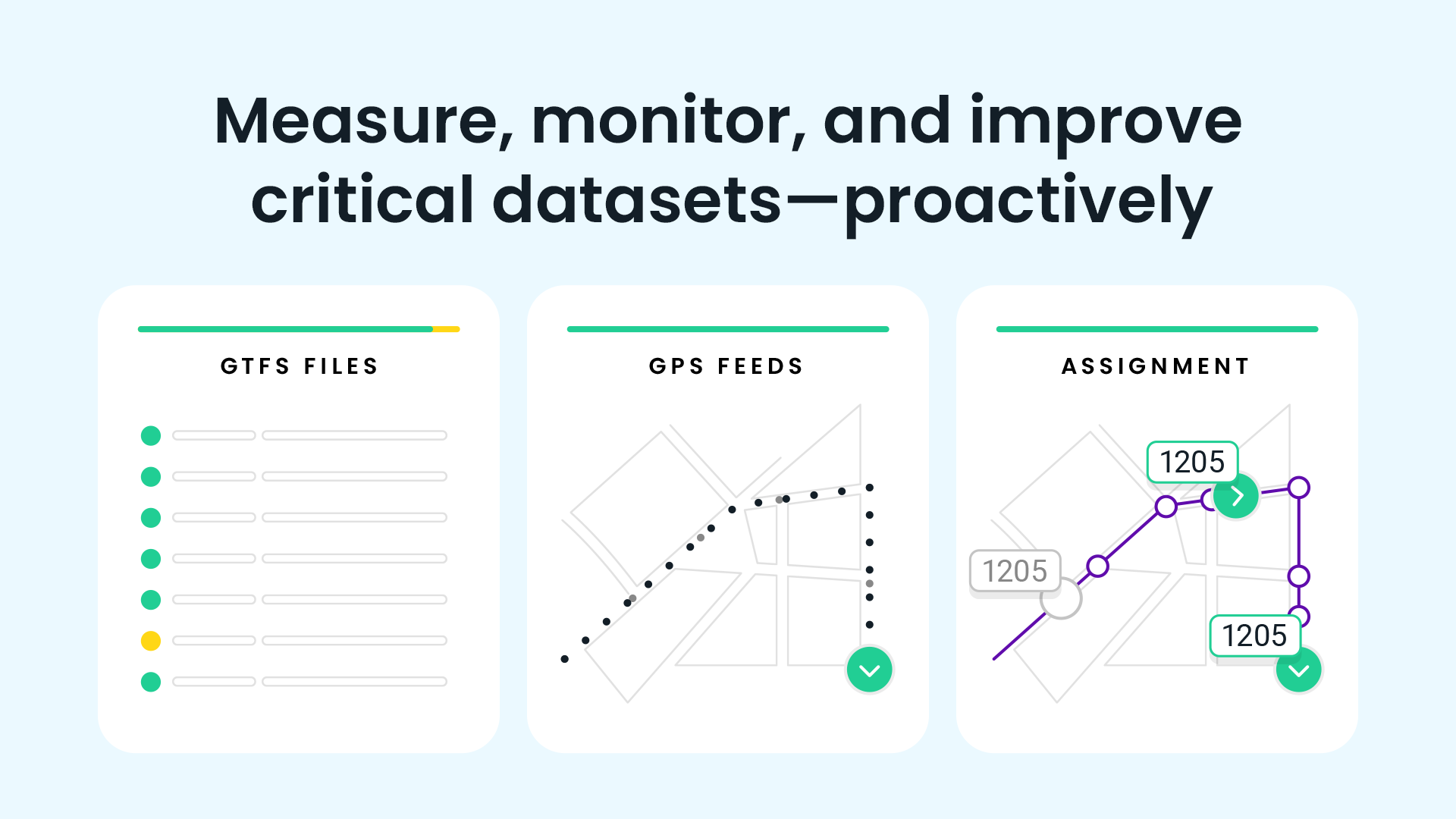
October 5, 2021
Introducing APC Connector: Ridership Data Done Right

October 5, 2021
Introducing APC Connector: Ridership Data Done Right
October 5, 2021
Introducing APC Connector: Ridership Data Done Right
Accurately measuring ridership today is much too hard
Ridership is one of the most important metrics in all of transit. Not only does ridership hold the key to understanding where passengers are going and when, but it also helps secure federal funding and offers a snapshot of the overall health of a transit agency. So why is it so hard to accurately capture and analyze?
One key problem is that most CAD/AVL vendors leave APC integrations as an afterthought. Deploying a new system is expensive because it requires an onboard computer or VLU to process data, and receiving accurate information is a consistent challenge – onboard wiring mistakes are common, unvalidated data often gets jumbled with meaningful passenger counts, and calibration “drift” is rarely accounted for. APC hardware itself is not often the issue; the challenge is the way APC units are integrated into the data pipeline.
Here at Swiftly, we believe that ridership data is far too important to let the problem go unanswered. That’s why we’re launching our latest product, which modernizes the process of capturing and analyzing ridership metrics. We’re calling it APC Connector.
Introducing Swiftly’s APC Connector, ridership data done right
APC Connector is ridership data done right. APC Connector allows Swiftly customers to connect their Automatic Passenger Counters (APCs) directly to the internet, bypassing the issues that most commonly trip up APC integrations. Users simply connect their Iris APC sensors to an onboard router, and Swiftly intakes the raw data, processes and analyzes it, and presents it in the most common data formats.
APC Connector is different from existing solutions in that it’s modular, API-friendly, and 100% cloud-based. With APC Connector, the integration between Swiftly and APC units is purely over the Internet. Because Swiftly can associate the APC data with the right trip and block assignments remotely, there's no need for any local processing onboard the vehicle. As a result, APC deployments don't have to be hardwired to an onboard CAD/AVL computer or Vehicle Logic Unit (VLU): the data can go directly to the internet via the router, and Swiftly matches it to the right trips, runs, blocks, and stops. Real-time and historical ridership counts all flow into one central place, and the data can be shared with common passenger apps like Transit and Google Maps, downloaded via CSV files, or shared with third party applications via API exports – whichever fits the agency’s workflow. And, best of all, there is no Swiftly hardware on the vehicle to process the data.
APC Connector also provides Real-time crowding information for both passengers and internal staff. For Swiftly Real-time Passenger Predictions customers, passengers can see real-time crowding in rider-facing apps like Transit and Google Maps. In Live Operations, staff can view passenger loads in real time, enabling operations to adjust service according to crowding levels.
APC Connector is part of Swiftly’s Metronome product line, which aims to break agencies free of the tangle of hardware-centric transit tools that have dominated the transit industry for decades. Because traditional VLU and CAD/AVL deployments rely on physical wires and proprietary data to ingest APC data, in the past, agencies had one option when they were unhappy with their deployments: to “rip and replace” all of their onboard units and overhaul the entire fleet, costing thousands if not millions of dollars. Because APC Connector is 100% cloud-based, there’s no Swiftly hardware on vehicles. In this way, APCs, VLUs, and CAD/AVLs become more modular in nature — one step closer to mixing and matching whichever solutions are preferred and transcending “vendor lock-in.”
And for smaller agencies that don’t currently use APCs on their vehicles, APC Connector removes the need to use VLUs or CAD/AVL systems to process ridership data, eliminating the costliest part of a typical APC deployment and bringing automated ridership counts within reach.
Common use cases and benefits of APC Connector
Below are some of the most common uses for APC Connector:
Optimizing planning decisions that distribute resources in a way that benefit the greatest number of riders.
- This could include temporary stop placements, stop amenity upgrades, network redesigns, and infrastructure projects like Transit Signal Priority.
Reporting ridership figures to the National Transit Database (NTD).
Informing passengers of vehicle passenger loads helps keep everyone safe.
- This is only practicable with a fully automated system that integrates with the customer-facing apps agencies use. APC Connector can automatically send real-time crowding information to Transit, Google Maps, and more.
Informing regular schedule updates with passenger loads to identify capacity constraints and eliminate chronic overcrowding.
- Stop-by-stop boardings and alightings pinpoint opportunities for short turns, skipped stops, and other decisions that benefit the greatest number of riders.
Communicating with elected officials and the public through community and public hearings to make cases based on ridership counts.
Adjusting service in real-time to ensure social distancing and rider comfort when vehicles become crowded.
Counting alightings in addition to boardings.
- This enables agencies to understand vehicle loads, overcrowding, and origin/destination patterns of ridership. APC Connector can manage both boardings and alightings and presents the data in easy-to-parse formats.
Counting fare-free customers.
- Fareboxes can’t count fare-free riders. This limitation has been exacerbated as many agencies have gone fare-free during the COVID-19 pandemic. APC Connector makes it much easier and practical to validate or audit fare collection rather than proxies like farebox tallies.
And some of the biggest benefits of APCs in general:
Accuracy
- Modern Automatic Passenger Counters are highly accurate, whereas manual counting is subject to human error by vehicle operators who have other, higher priorities — like driving safely and keeping customers happy. APC Connector makes it much simpler to rely on APCs rather than defaulting to hand-tallying boardings and alightings.
Safety
- Asking drivers to count every passenger is a distraction that may impact safe driving. APC Connector makes it much simpler to let an APC do the job of tallying riders, rather than the operator.
Agencies already love APC Connector
Transit professionals are already seeing the benefits of APC Connector at their agencies (read our case study with RTA Maryland for the full story):
“Swiftly’s APC Connector is an automatic way to collect ridership data and seamlessly pair it against the static schedule and real-time data. It gives you the benefits of the APC without having to set up hardware manually. It works seamlessly with the data we already have, so we’re leveraging the strength of our current system. If we change something it is reflected immediately." —Cole McCarren, RTA Maryland
"Not only is this going to save our agency a whole lot of work because we don’t have to worry about keeping a dozen different databases up to date, but we can have a much more centralized approach for a decentralized deployment. It’s going to have better outcomes, because things are more accurate. There won’t be a lot of duplication. And agencies are going to have flexibility, because if vendors can build around these standards, we’re going to be able to foster more marketplace competition, which will have better results for the industry as a whole. And I think big and small agencies all have a role to play in pushing the industry in that direction.”
Give ridership data the flexibility it deserves
Ridership is one of the most fundamental aspects of public transit. With APC Connector, we’re excited to give agencies a modern solution that will help paint a detailed, real-time picture of ridership in their service area. Ridership is too important of a metric not to.
Want to see how APC Connector could work at your agency? Reach out for an in-depth demo.
Request a demo
The rich text element allows you to create and format headings, paragraphs, blockquotes, images, and video all in one place instead of having to add and format them individually. Just double-click and easily create content.
Last Name, Agency

What’s a Rich Text element?
What’s a Rich Text element?
What’s a Rich Text element?
What’s a Rich Text element?
What’s a Rich Text element?
The rich text element allows you to create and format headings, paragraphs, blockquotes, images, and video all in one place instead of having to add and format them individually. Just double-click and easily create content.
Last Name, Agency
Static and dynamic content editing
A rich text element can be used with static or dynamic content. For static content, just drop it into any page and begin editing. For dynamic content, add a rich text field to any collection and then connect a rich text element to that field in the settings panel. Voila!
How to customize formatting for each rich text
Headings, paragraphs, blockquotes, figures, images, and figure captions can all be styled after a class is added to the rich text element using the "When inside of" nested selector system.
- text goes here
- text goes here
- text goes here
- text goes here
- text goes here
- text goes here









